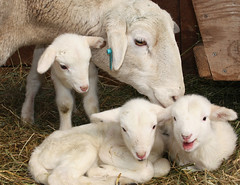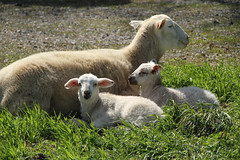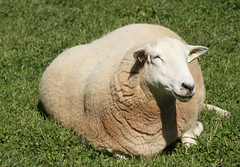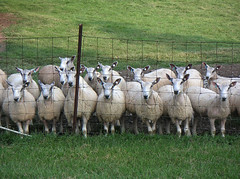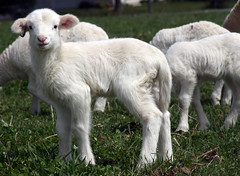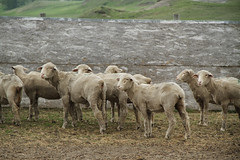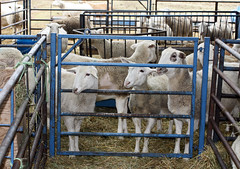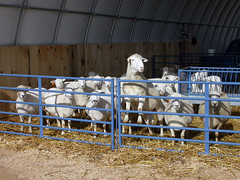- Sheep 201 Index
- Other web sites

Gestation averages 147-148 days.
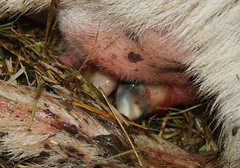
Parturition
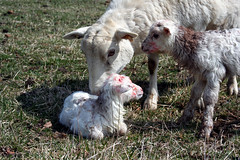
Just born

Polypays: less seasonal

Ewe lamb in heat

Hampshire ewes being fed
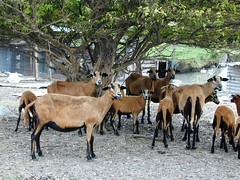
Barbados Blackbelly ewes
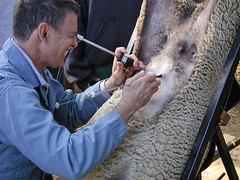
Laparoscopic AI

Trans-cervical AI
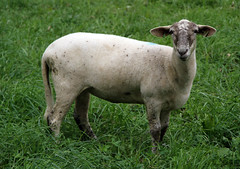
Replacement ewe lamb
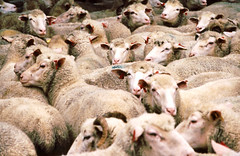
Whiteface ewes
Reproduction in the eweReproductive rate is defined as the number of live lambs born per ewe exposed for breeding. Optimal reproductive rates are essential to profitable sheep production. Optimal reproductive rate varies by farm, production system, and geographic area.
Puberty (sexual maturity)
Puberty is when a ewe reaches sexual maturity and exhibits estrus (heat) for the first time. The age of puberty is influenced by breed, genetics, size (weight), nutrition, and season of birth. Most ewe lambs reach puberty between 5 and 12 months of age.
Ewe lambs will tend to reach puberty their first fall. For this reason, spring-born ewe lambs tend to exhibit puberty earlier than fall-born ewe lambs. Lambs born early in the season reach puberty earlier than those born later in the season, due to their increased age and body weight. One way to select for early puberty is to expose ewe lambs for breeding and scan them for pregancy, culling any ewe lambs which fail to become pregnant.
High levels of feed pre and post-weaning reduce the age at puberty. Single lambs cycle at a younger age than twin and triplet-born ewe lambs, due to their size advantage. Ewe lambs from fine-wool, coarse wool, and late-maturing medium-wool breeds reach puberty later than many of the meat (Suffolk, Dorset, etc.) and hair sheep (Katahdin, St. Croix, and Barbados Blackbelly) breeds. Finnsheep and Romanov ewe lambs and their crosses reach puberty at an earlier age than most breeds. Crossbred ewe lambs cycle at a younger age than purebred ewe lambs.
The estrus (or heat) cycle
Reproduction in non-human mammals is regulated by an estrus cycle. In sheep, the length of the estrus cycle ranges from 13 to 19 days and averages 17 days. There are four phases to the estrous cycle: proestrus, estrus, metestrus, and diestrus. Estrus is the period of time when the ewe is receptive to the ram and will stand for mating. It lasts approximately 24 to 36 hours.
Ovulation (release of eggs by the ovary) occurs in mid to late-estrus. Metaestrus begins with the cessation of estrus and lasts for about 3 days. Primarily it is the period of the formation of corpus luteum (CL). The corpus luteum produces progesterone and maintains pregnancy in the ewe. Diestrus is the period of the estrus cycle when the CL is fully functional.
Proestrus begins with the regression of the CL and drop in progesterone and extends to the start of estrus. Rapid follicular growth is occuring during this period. It usually extends from day 4 to day 13-15 of the cycle. Anestrus refers to a state where the normal cycle stops.Estrous cycles are usually affected by season. The number of hours daily that light enters the eye of the animal affects the brain, which governs the release of certain precursors and hormones. Most sheep are seasonally polyestrus and short-day breeders. They will begin to exhibit estrus when length of day begins decreasing. They will come into heat every 16 to 17 days until they are bred or return to anestrus. Thus, the most natural time for sheep to breed in the U.S. and Canada is the fall (Oct-Nov).
Some sheep breeds are less seasonal. They breed almost year-round or have an extended breeding season. The less seasonal breeds include Dorset, Rambouillet, Merino, Finnsheep, Romanov, Karakul, and hair sheep. The most seasonal breeds are the British long wool and meat breeds. The closer the flock is located to the equator, the longer the breeding season and the less complete and shorter will be the seasonal anestrus.
Signs of estrus in the ewe are much less pronounced than in the cow or doe and can usually not be detected unless a ram is present. When mature ewes are in heat, they will seek out the ram and stand still for him to mount them. Sometimes they wag their tails vigorously. They may nuzzle the ram around the belly or scrotum and even try to mount the ram. Young ewes rarely exhibit these behaviors. There is evidence to suggest that rams and ewes prefer to mate with their own breed, but when there is no option ewes will mate with almost any breed of ram.
Reproductive characteristics of ewes
Age at puberty, Length of estrus cycle, days Duration of estrus, hours Timing of ovulation Gestation, days
Pre-Breeding
Prior to breeding, ewes should be evaluated for their need for deworming. They should have their hooves trimmed, if necessary. If there is a history or risk of abortions in the flock, ewes should be vaccinated prior to breeding. It goes without saying that only healthy, reproductively sound ewes should be exposed to rams for breeding.
The udder of every ewe should be examined. Those with unsound udders should be culled. Ewes that prolapsed their vaginas the previous lambing should not be kept for breeding, because there is a high probability for reoccurance. Ewes that did not raise a lamb should be culled. Ewes that are in poor body condition due to age and/or missing teeth should be culled. Ewes with chronic hoof problems (e.g. foot rot) should be culled.
Gestation (pregnancy)
The average gestation length in sheep varies from 142 to 152 days. The average is 147 days. Individual pregnancies may vary from 138 to 159 days. There are breed differences in gestation length. The earlier maturing breeds (e.g. Finnsheep) tend to have shorter pregnancies than the late maturing breeds (e.g. Rambouillet). Ewes carrying multiple births tend to have shorter gestations. Male lambs and heavy birth weight lambs are usually carried longer than female lambs.The period of early gestation most critical to success during the lambing season is the first 30 days after fertilization. The first 21 to 30 days after breeding is when embryonic implantation occurs. This first 30 days is when most embryonic mortality occurs. Thus, anything that can be done to reduce embryonic mortality and should result in more lambs born.
Shearing, vaccinating, working ewes, pronounced changes in feeding practices should be avoided during the first 30 days of gestation. Ultrasonic pregnancy scanning can be done on ewes from 35 to 60 days after breeding, depending on equipment used and operator skill. Nutrition during early gestation is quite simple. Ewes need only slightly above maintenance levels of nutrition for the first 15 weeks of pregnancy. Mid-gestation is important for development of the placenta.Late gestation (last 4 to 6 weeks) is a critical period for ewe reproduction. This is when the majority of fetal growth is occurring, placing increasing nutritional demands on the ewe. Ewes consuming inadequate diets are prone to pregnancy toxemia and milk fever. Nutrition in late-pregnancy affects the size and vigor of lambs and the milk producing ability of the ewe.
Parturition (lambing)
There are three stages to parturition (lambing): 1) dilation of the cervix; 2) expulsion of the fetus(es); and 3) expulsion of the placenta. Stage one usually takes 3 to 4 hours. The birth of a lamb usually occurs within an hour of less from the rupture of the first water bag. A ewe lambing for the first time or with multiple births may take longer.
If labor takes over an hour for mature ewes and over 2 hours for ewe lambs, assistance may be required. The placenta is passed 2 to 3 hours after delivery is finished. In multiple births, there are separate afterbirths for each lamb. After the lamb is born, the ewe will lick and nuzzle it to begin the bonding process.
Breeding Ewe Lambs
Ewe lambs should not be bred until they achieve approximately 70 percent of their mature size (weight). At the same time, care should be taken not to overfeed replacement ewe lambs. Research has shown that overfeeding pre-pubertal females (2 to 4 months of age) has a detrimental effect on mammary development (they deposit excess fat in their udders) and affects subsequent milk producing ability. Replacement ewe lambs should be fed separately than market lambs or ram lambs being fed for market. Ewe lambs should be fed higher forage diets. Frame growth is more imporant than fat deposition.Pregnant and lactating ewe lambs should be kept separate from mature ewes. Ewe lambs require extra nutrition because they are still growing. They will not compete well at the feed bunk with mature ewes and will not gain weight properly. Ewe lambs that are forced to run with the ewe flock will lose weight in late gestation and lactation.
Single-births are common with ewes lambs, but twins and triplets are not uncommon with the more prolific breeds. Even when management and nutrition are proper, more lambing problems will be encountered with ewes lambing for the first time at 12 to 14 months of age.While breeding ewe lambs increases their lifetime productivity, it may not be economically advantageous for all producers. Intensively managed sheep operations usually benefit from breeding ewe lambs.
Minimum weight to breed ewe lambs
Controlling reproduction in the ewe
When satisfactory results are not obtained under natural breeding conditions, it is possible to artificially manipulate the reproductive cycle of sheep.
Hormonal control
A common method of inducing estrus in non-cycling ewes is progesterone-based therapies. Progesterone prevents the ewe from returning to estrus and ovulating. It is produced by the corpus luteum (CL) of the ovary following ovulation and sustains pregnancy. When progesterones are introduced artificially, they fool the body into thinking it is pregnant and the animal will not ovulate or come into estrous (heat).
When the progesterone source is totally removed, the body realizes it is no longer pregnant and will ovulate within a very predictable period. Progestins refer to the synthetic compounds with the properties of progesterone. These substances mimic the function of the CL. Progestogens (synthetic analogs of progesterone) can be provided by feeding (MGA), implants under the skin (Synchro-Mate B®), sponges (or pessaries) inserted into the vagina, or plastic delivery devices inserted into the vagina (CIDR).Intravaginal sponges (or pessaries) have been the traditional method of inducing and/or synchronizing estrus in ewes. They contain progestagens that are effective at lower doses than natural progesterone. Two types of sponges are Chronogest (FGA) and Veramix® (MAP).
Intravaginal sponges are usually inserted over periods of 9 to 19 days and are used in conjunction with PMSG, injected at the time of sponge removal or 48 hours prior to sponge removal. Intravaginal sponges have high retention rates (>90%) and females usually exhibit estrus 24 to 48 hours after removal. Responses to intravaginal sponges have varied according to breed, protocol, co-treatment, management, and mating system.CIDR™ (controlled internal drug release) devices are made of progesterone-impregnated medical silicone elastomers and were developed in New Zealand. Protocols for the use of CIDR™ devices is usually identical to protocols for intravaginal sponges. Research has shown that CIDR™ devices and intravaginal sponges yield similar results. CIDR™ devices are approved for use in sheep in the U.S.
Synchro-mate-B® is a cattle implant that contains 6 mg of the synthetic progestagen norgestomet. One-third or one-half of the Synchro-mate-B® implant is typically used in ewes. Implantation periods range from 9 to 14 days. Two days before the end of the implantation period, injections of PMSG and /or PGF2a are usually given.
Melengesterol acetate (MGA®) is an orally active, synthetic progestagen developed and used to suppress estrus in feed lot heifers. The use of this product requires the feeding of a supplement containing MGA® once or twice daily for a duration of 8 to 14 days. Protocols usually include co-treatments with PMSG, P.G. 600® or Ralgro® (zeranol).
Ralgro® is a commercially available growth promotant for cattle and sheep with estrogen-like effects on LH and FSH concentrations. P.G. 600® is the only veterinary grade source of PMSG readily available in the U.S. Estrus responses to MGA feeding vary, but are usually higher with co-treatment.Prostaglandin
Prostaglandin-based protocols are only applicable to cycling ewes and are restricted to use during the breeding season. The two commonly used products are Lutalyse™(PGF2a) and Estrumate® (cloprostenol). Prostaglandins cause regression of the CL, telling the body than no pregnancy exists. The ewe will ovulate within a very predictable time.
When a single treatment of prostaglandin is given to a flock of cycling ewes, 60 to 70 percent of the flock will exhibit a synchronized estrus beginning 30 to 48 hours later. A double injection system (11 days apart) is most common in sheep.Melatonin
Melatonin treatments have been shown to be an effective method of inducing estrus in non-cycling ewes. Melatonin is called the "hormone of darkness," because it is released by the pineal gland during the night. Treatment with melatonin therefore mimics the short days of fall and induces estrus after a minimum of approximately 35 days of treatment.It is important to note that most of the pharmacological treatments described above have been approved by the U.S. Food and Drug Administration for use in sheep, though they may be available to producers in other countries.
Light Control
Controlled lighting can be used to initiate estrus. Short-day breeders like sheep may be programmed to cycle if they are maintained in a light-tight building where the photoperiod is reduced gradually over an 8 to 12 week period. Rams should be exposed to the same light regiment to obtain high fertility. Light control is usually impractical for most producers.
The "ram effect"
The "ram effect" is when non-cycling ewes are stimulated to ovulate by the sudden introduction of an intact male or "teaser" (vasectomized) ram. Rams produce a chemical substance called a pheromone, the smell of which stimulates the onset of estrus. When ewes and rams are in constant contact (sight or smell), the pheromones are much less effective at inducing estrus.
Ewes that are not cycling when a ram (or teaser) is introduced will genrally ovulate in 3 to 4 days. This first ovulation will be a "silent" heat, which cannot be detected by the ram. Following this silent heat, there will be two normal estrus peaks, with some ewes cycling around day 18 and the remainder around day 25.
Ewes that do not conceive at either of these times may return to heat in another 17 days. It is expected that 60 to 70 percent of the ewes will conceive at the first normal estrus. Of the remaining ewes, 60 to 70 percent should conceive at the second estrus.Although recommendations vary, rams should be isolated from ewes for at least 6 weeks in order for the ram effect to work. Ewes must have no contact with rams by either sight or smell, which means that they must be separated by distance.
The ram effect is not as effective with ewe lambs. The ram effect is most effective during the transitional period when ewes have not begun to cycle, but are almost ready to. Breed of ram can affect ewes' response to the ram effect, with the less-seasonal breeds being more effective at bringing non-cycling ewes into estrus. There are also differences among ewes, in their response to the ram effect.The greatest value of the ram effect is the synchronization of estrus activity which will result in large numbers of ewes ovulating, conceiving, and lambing in a relatively short period of time. To be effective, it is important to have adequate numbers of young, healthy rams. Teaser (vasectomized) rams or testosterone-treated wethers can also stimulate the ram effect.
Selection
Selection is another method to obtain early lambing flocks, but it requires a long term commitment. Heritability is generally thought to be less than 10 percent. Researchers at Virginia Tech were able to decrease the seasonal anestrus to 11 days in a crossbred flock of 1/2 Dorset x 1/4 Rambouillet x 1/4 Finnsheep by selecting for spring fertility.
Artificial insemination (AI)
Artificial insemination is possible in sheep, but not common in the United States. This is because the ewe has a very complicated cervix which makes trans-cervical A.I. as is done with cattle, swine, and goats more difficult. As compared to other livestock, the ewe shows few visible signs of heat (estrus). Breed improvement in the sheep industry has been much slower to develop and the industry lacks a means to identify superior genetics.There are four methods of artificially inseminating a ewe: vaginal, cervical, trans-cervical, and intrauternine.
Vaginal AI
Vaginal is the simplest form of insemination and involves depositing fresh semen into the anterior vagina without any attempt to locate the cervix. Reported success rates are highly variable and this method is unsuitable for use with frozen semen.Cervical AI
Cervical is another cheap and relatively easy method of insemination. The cervix is located, via a speculum fitted with a light source, and the semen is deposited into the first fold of the cervix. Conception rates with fresh or chilled semen are good, but generally unacceptably low with frozen, thawed semen.Trans-cervical AI
The trans-cervical method of insemination involves grasping the cervix and retracting it into the vagina with a pair of forceps to allow an inseminating instrument to be introduced into the cervical canal. The University of Guelph (Canada) has developed an instrument with a special bent tip that allows passage through the cervix.Laparoscopic AI
Laparoscopic AI, also known as intrauterine, by-passes the cervix and deposits semen directly into the uterine horns. In 1982, Australian researchers developed the laparoscopic insemination (LAI) procedure that revolutionized the sheep AI technique. LAI is a minimally invasive, minor surgical procedure that requires veterinary expertise.
The technique utilizes an endoscope, a special telescope with a fiberoptic light, which permits the technician to view the ewe’s reproductive tract. The semen is injected directly into the lumen of the uterus, and the same procedure is repeated on the other uterine horn. The procedure takes 2 to 5 minutes per ewe. After the procedure is over, the ewe normally starts eating within minutes. Conception rates range from 50 to 80 percent with laparoscopic AI.Embryo Transfer (ET)
Embryo transfer is a technique whereby embryos are harvested from the ewe's reproductive tract before they have attached to the uterus. This technique allows the production of a greater number of offspring from a given female, the "donor", without requiring her to carry all the offspring. For sheep, the embryo transfer technique most often used is a surgical procedure, both for collecting the embryos and for transferring them into the recipients.
<== SHEEP 201 INDEX
Copyright© 2021. Sheep 101 and 201.

